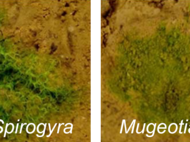Functional analysis of GRAS proteins and their role in the transition of plants from water to land
Around 500 mya the ancestors of Zygnematophyceae algae, the sister lineage to land plants that gave rise to embryophytes, moved from water to land. The adaptation of plants to dry and nutrient poor terrestrial habitats was facilitated by evolutionary innovations enabled by transforming cellular transcriptional programs and gene functions driven by the expansion of gene families followed by sub- or neofunctionalization of some of their family members. In this proposed project we will analyze the evolutionary relationship and functional roles of a
set of transcription factors which are specifically present in genomes of Zygnematophyceae species and land plants. Genes encoding members of the GRAS protein family increase resistance to biotic and abiotic stresses in land plants, in particular desiccation. They originated or expanded in the common ancestor of Zygnematophyceae and embryophytes. Moreover, GRAS-like sequences were only found in embryophytes, Zygnematophyceae, and bacteria, suggesting that GRAS proteins in plants evolved through horizontal gene transfer from bacteria. GRAS proteins are also required for the development of the arbuscular mycorrhizal symbiosis (AMS) which is an intimate association between soil fungi and roots of most land plants. The AMS is thought to have played a crucial role in the initial colonisation of land by plants and to date this symbiosis mitigates environmental stress and fascilitates uptake of water and nutrients in mycorrhizal roots. We hypothesize that a “GRAS regulatory network” is involved in the adaptation to environmental stress in Zygnematophytes. It could thus be that GRAS proteins protected ancestral algae from drought and/or nutrient deprivation and were later recruited for AMS development in land plants.
set of transcription factors which are specifically present in genomes of Zygnematophyceae species and land plants. Genes encoding members of the GRAS protein family increase resistance to biotic and abiotic stresses in land plants, in particular desiccation. They originated or expanded in the common ancestor of Zygnematophyceae and embryophytes. Moreover, GRAS-like sequences were only found in embryophytes, Zygnematophyceae, and bacteria, suggesting that GRAS proteins in plants evolved through horizontal gene transfer from bacteria. GRAS proteins are also required for the development of the arbuscular mycorrhizal symbiosis (AMS) which is an intimate association between soil fungi and roots of most land plants. The AMS is thought to have played a crucial role in the initial colonisation of land by plants and to date this symbiosis mitigates environmental stress and fascilitates uptake of water and nutrients in mycorrhizal roots. We hypothesize that a “GRAS regulatory network” is involved in the adaptation to environmental stress in Zygnematophytes. It could thus be that GRAS proteins protected ancestral algae from drought and/or nutrient deprivation and were later recruited for AMS development in land plants.
The project will be supervised by Marcel Bucher at the University of Cologne.
